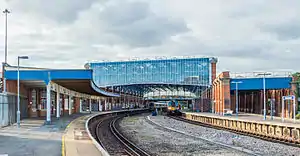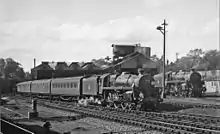Bournemouth railway station
Bournemouth railway station is the main railway station serving the beach-side town of Bournemouth, Dorset, England. It was previously known as Bournemouth East (1885 to 1899) and then Bournemouth Central (1899 to 1967). It has long been treated as an obligatory stop (major stop) on the South Western Main Line from London Waterloo to Weymouth. It is 108 miles 2 chains (173.8 km) down the main line from Waterloo[note 1] and is situated between Pokesdown and Branksome.
 | |
| Location | Bournemouth, Bournemouth, Christchurch and Poole England |
| Grid reference | SZ096919 |
| Managed by | South Western Railway |
| Platforms | 4 |
| Other information | |
| Station code | BMH |
| Classification | DfT category C1 |
| History | |
| Pre-grouping | London and South Western Railway |
| Post-grouping | Southern Railway |
| Key dates | |
| 20 July 1885 | Opened (Bournemouth East) |
| 1 May 1899 | Renamed (Bournemouth Central) |
| 10 July 1967 | Renamed (Bournemouth) |
| Passengers | |
| 2015/16 | |
| Interchange | |
| 2016/17 | |
| Interchange | |
| 2017/18 | |
| Interchange | |
| 2018/19 | |
| Interchange | |
| 2019/20 | |
| Interchange | |
| Notes | |
Passenger statistics from the Office of Rail and Road | |
Railways in the Bournemouth area | ||||||||||||||||||||||||||||||||||||||||||||||||||||||||||||||||||||||||||||||||||||||||||||||||||||||||||||||||||||||||||||||||||||||||||||||||||||||||||||||||||||||||||||||||||||||||||||||||||||
|---|---|---|---|---|---|---|---|---|---|---|---|---|---|---|---|---|---|---|---|---|---|---|---|---|---|---|---|---|---|---|---|---|---|---|---|---|---|---|---|---|---|---|---|---|---|---|---|---|---|---|---|---|---|---|---|---|---|---|---|---|---|---|---|---|---|---|---|---|---|---|---|---|---|---|---|---|---|---|---|---|---|---|---|---|---|---|---|---|---|---|---|---|---|---|---|---|---|---|---|---|---|---|---|---|---|---|---|---|---|---|---|---|---|---|---|---|---|---|---|---|---|---|---|---|---|---|---|---|---|---|---|---|---|---|---|---|---|---|---|---|---|---|---|---|---|---|---|---|---|---|---|---|---|---|---|---|---|---|---|---|---|---|---|---|---|---|---|---|---|---|---|---|---|---|---|---|---|---|---|---|---|---|---|---|---|---|---|---|---|---|---|---|---|---|---|---|
| ||||||||||||||||||||||||||||||||||||||||||||||||||||||||||||||||||||||||||||||||||||||||||||||||||||||||||||||||||||||||||||||||||||||||||||||||||||||||||||||||||||||||||||||||||||||||||||||||||||
A previous incarnation of Bournemouth East station was on another site. Ticket barriers were installed in 2008 and British Transport Police have a Bournemouth office at the station which acts as a regional hub.[1]
History

The station was designed by William Jacob, chief engineer of the London and South Western Railway, and opened on 20 July 1885 as Bournemouth East replacing the original station of the same name on the other side of Holdenhurst Road from 1870 to 1885, see Bournemouth East railway station (Ringwood, Christchurch and Bournemouth Railway).[2] The station was over 1–km from the town centre on the insistence of town authorities of the time. It was renamed Bournemouth Central on 1 May 1899 and became Bournemouth on 10 July 1967 following the closure of Bournemouth West. By 1967 third rail electrification had reached Bournemouth and continued beyond to Branksome and Bournemouth Train & Rolling Stock Maintenance Depot but no further. From the end of steam most trains were formed of 4REP EMUs coupled up with one or more unpowered 4TC units. The 4TC units would be uncoupled at Bournemouth and attached to a Class 33/1 diesel locomotive for the onward journey to Weymouth. This continued until the electrification of the line from Branksome to Weymouth and the introduction of Class 442 units in 1988. The end of steam also saw the removal of the station's centre tracks which ran between the up and down lines serving platforms 2 and 3 respectively and the demolition of the locomotive sheds to the west; the station car park took over their site.
The station roof was severely damaged by the Great Storm of 1987 that hit the South of England. It was extensively refurbished in 2000 by Railtrack after many years of disrepair and being surrounded by scaffolding to protect people from falling debris.
Ticket barriers were installed in 2008.
Bournemouth railway station was once served by services and goods deliveries across five railways, the South Western Main Line, Southampton and Dorchester Railway, Ringwood, Christchurch and Bournemouth Railway, Salisbury and Dorset Junction Railway and Somerset and Dorset Joint Railway.
Accidents and incidents
On 2 September 1961, a train was derailed by trap points at the end of the down platform (towards the west).[3]
Layout
The station has four platforms:
- Platform 1 – east facing bay platform capable of accommodating trains of up to four 20-metre coaches. As of 2012 there are no scheduled services from this platform.[4]
- Platform 2 – for through services to the east towards Southampton & London Waterloo
- Platforms 3 and 4 – for terminating services from London and through services to Weymouth, platform 4 is rarely used by trains in passenger service.
Platforms 3 and 4 are continuous, and both can accommodate full-length trains. This means Bournemouth has one of the longest platforms in the country. Other stations with this arrangement include Gloucester, Cambridge and Edinburgh Waverley.
Motive power depot

A small locomotive depot was opened at Bournemouth East in 1870, but closed in 1883.[5] This was replaced by a larger shed, adjacent to Bournemouth Central station, in 1883. This in turn was supplemented by another shed nearby in 1888. In 1921, the 1883 shed was closed and the 1888 one was extended to increase capacity, and between 1936 and 1938 this was rebuilt and enlarged. The new shed included a 65 ft (20 m) turntable and a 50 LT (51 t) hoist. However the facilities remained cramped and awkwardly sited; there were proposals to move the depot to Branksome which were never implemented. This site therefore remained in use until June 1967 when the site was cleared.[6]
Services

Rail
The station is primarily served by South Western Railway, who operate fast and semi-fast trains from London Waterloo to Weymouth, and stopping services from London Waterloo to Poole.[7]
CrossCountry operate services from Bournemouth to Manchester Piccadilly via Birmingham New Street.[7] There is one CrossCountry service Monday to Saturday only from Nottingham but no return working.[8] All CrossCountry services at Bournemouth use Voyagers. Before the CrossCountry service was standardised in 2007 there were for many years CrossCountry services to many other destinations, including the Dorset Scot, Pines Express and Wessex Scot and other trains to Scotland via both the West Coast Main Line and East Coast Main Line, along with trains to Leeds and to Liverpool Lime Street.
| Preceding station | Following station | |||
|---|---|---|---|---|
| Brockenhurst | CrossCountry Manchester–Bournemouth |
Terminus | ||
| Brockenhurst or Southampton Central |
South Western Railway London–Weymouth express services |
Branksome or Terminus | ||
| Pokesdown for Boscombe |
South Western Railway London–Weymouth semi-fast services |
Poole | ||
| Pokesdown for Boscombe |
South Western Railway London-Poole stopping services |
Branksome | ||
| Historical railways | ||||
| Boscombe Line open, station closed |
London and South Western Railway Southampton and Dorchester Railway |
Meyrick Park Halt Line open, station closed | ||
In May 1994, Network SouthEast extended its service London Victoria to Southampton service to terminate at Bournemouth.[9] It was truncated back to Southampton in the 2000s by Southern. The service was one of the few regular services to use platform 1.
Bus
Bournemouth railway station also serves as a hub for local bus services. On the down side of the station is Bournemouth Travel Interchange which is served by Wilts & Dorset and Yellow Buses, both companies operate frequent services to the town centre. A regular bus service to Bournemouth Airport, the Bournemouth Airport Shuttle, is operated by Yellow Buses. It is also a stop on National Express coach routes which serve the town.
Notes
- Railways in the United Kingdom historically are measured in miles and chains. There are 80 chains to one mile.
References
| Wikimedia Commons has media related to Bournemouth railway station. |
- "Archived copy". Archived from the original on 17 December 2008. Retrieved 2008-12-14.CS1 maint: archived copy as title (link)
- "Bournemouth Central - History" semgonline.com
- Trevena, Arthur (1981). Trains in Trouble: Vol. 2. Redruth: Atlantic Books. p. 42. ISBN 0-906899 03 6.
- Mortimer, Simon (2007). Baywatch (4th edition). Kentrail Enthusiasts Group.
- Griffiths, Roger; Paul Smith (1999). The directory of British engine sheds. 1. Oxford: Oxford Publishing Co. p. 50. ISBN 0 86093 542 6.
- Hawkins, Chris; George Reeve (1979). An historical survey of Southern sheds. Oxford: Oxford Publishing Co. p. 15. ISBN 0 86093 020 3.
- Services calling at Bournemouth on 4 February 2020 Real Time Trains
- Table 51 & 158 National Rail timetable, May 2017
- Network SouthCentral goes west Rail issue 230 6 July 1994 page 19